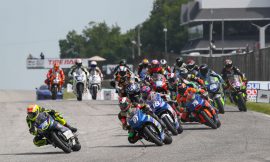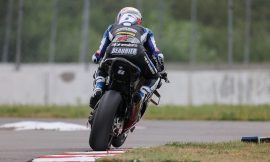
Despite the never-ending, always evolving march of technology, road racing motorcycles—as has been the case since the very beginning of road racing—still have manual transmissions, with six cogs or “speeds” to choose from.
Across all five race classes, virtually all of the motorcycles competing in the MotoAmerica Series are equipped with two important innovations to their manual or “standard” transmissions: quickshifters and autoblippers.

You’ve probably heard about them, and perhaps your own bike is even equipped with them, but let’s discuss the whys and wherefores of quickshifters and autoblippers.
We’ll start with a brief review of the process of shifting gears on a motorcycle. Pull in the clutch lever and close or “roll off” the throttle simultaneously, place your left foot on the gearshift lever and press down to upshift (on a road racing motorcycle, it’s “down” to upshift and up to downshift or “backshift”), “blip” the throttle, release the clutch lever, and twist the throttle. If you’re good, you can get all that accomplished in mere fractions of a second.

But, no matter how smooth or adept you are, a quickshifter enables you to shift gears much more quickly, without any loss of forward momentum, and without needing to use the clutch or roll off the throttle.
A quickshifter cuts off the ignition for just the miniscule amount of time it takes to snick the gearshift lever down a smidge. This micro-millisecond “pause” in the ignition enables the gears to smoothly slot into position and, because you don’t need to close the throttle, the drivetrain can give you the next level of acceleration without any loss in energy.
But how does the quickshifter know when to cut off the ignition? Most quickshifters have a mechanical sensor that is connected to the bike’s ECU. Some sensors are positional, which inform the ECU that the gearshift lever position is changing and to cut the ignition. On some bikes, there is a pressure sensor in the transmission itself, which informs the ECU of the variance in pressure that is detected when the rider’s foot presses down (for an upshift) or up (for a backshift) on the gearshift lever.
So, what is an autoblipper?
“Blipping” the throttle when backshifting is a technique that most road racers are either taught at an early age, or they learn it early on in their development as a racer. The process essentially matches the engine’s rpm to the next gear down prior to actually backshifting, which results in a smoother shift process.
An autoblipper works in concert with a quickshifter to improve the efficiency of your backshifting technique. The bike’s ECU blips the throttle for you, so you don’t have to. In a sport where mere thousands of a second can mean the difference between winning and losing—and that is a regular occurrence in the highly competitive and tightly contested MotoAmerica Series—quickshifters and autoblippers are as essential a part of a racebike as high-octane VP Racing fuel and sticky Dunlop race tires.
To purchase tickets for all MotoAmerica events, click HERE
For information on how to watch the MotoAmerica Series, click HERE
For the full 2020 MotoAmerica Series schedule, click HERE








